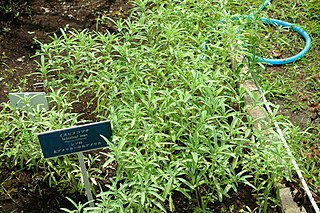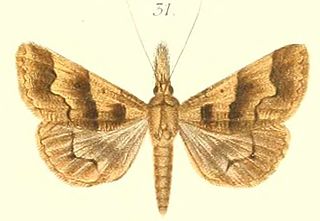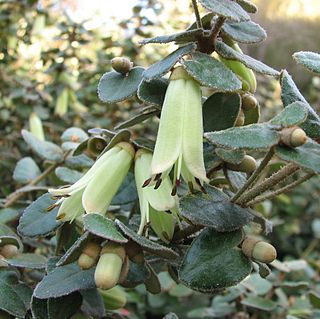Related Research Articles

Cuscuta (dodder) is a genus of over 201 species of yellow, orange, parasitic plants also known as Amar bail in India. Formerly treated as the only genus in the family Cuscutaceae, it now is accepted as belonging in the morning glory family, Convolvulaceae, on the basis of the work of the Angiosperm Phylogeny Group. The genus is found throughout the temperate and tropical regions of the world, with the greatest species diversity in subtropical and tropical regions; the genus becomes rare in cool temperate climates, with only four species native to northern Europe.

Correa is a genus of eleven species of flowering plants in the family Rutaceae that are endemic to Australia. Plants in the genus Correa are shrubs to small trees with simple leaves arranged in opposite pairs, bisexual flowers with four sepals, four petals usually fused for most of their length and eight stamens.

Dracaena reflexa is a tree native to Mozambique, Madagascar, Mauritius, and other nearby islands of the Indian Ocean. It is widely grown as an ornamental plant and houseplant, valued for its richly coloured, evergreen leaves, and thick, irregular stems.

Correa reflexa, commonly known as common correa or native fuchsia, is a shrub which is endemic to Australia.

Salvia reflexa, the lanceleaf sage, Rocky Mountain sage, blue sage, lambsleaf sage, sage mint or mintweed, is a perennial subshrub native to the United States and Mexico and introduced to Argentina, Australia, Canada, South Africa and New Zealand.

Ophyx is a genus of moths of the family Erebidae.

Polyarrhena is a genus of low, branching shrublets that is assigned to the daisy family. Its stems are alternately and densely set with entire or somewhat toothed leaves. Like in almost all Asteraceae, the individual flowers are 5-merous, small and clustered in typical heads, and which are surrounded by an involucre of in this case three whorls of bracts. In Polyarrhena, the centre of the head is taken by yellow disc florets, and is surrounded by one single whorl of white ligulate florets that have a pinkish-purple wash on the underside. These florets sit on a common base and are not individually subtended by a bract. The species occur in the Cape Floristic Region. Polyarrhena reflexa has long been cultivated as an ornamental and is often known under its synonym Aster reflexum.

Liparis reflexa, commonly known as tom cats, onion orchid or dog orchid, is a plant in the orchid family and is endemic to New South Wales. It is a lithophytic orchid with up to four leaves and up to thirty or more yellowish green flowers which smell like urine. It grows on rocks, sometimes on the ground, in moist forests.

Correa reflexa var. nummulariifolia, also known as roundleaf correa, is a variety of Correa reflexa endemic to Tasmania in Australia. It is a small shrub with leaves that are up to 12–26 mm long and 6–15 mm wide. The pendent flowers are tubular and yellow-green. The variety's distribution is restricted to islands of the Furneaux Group in Bass Strait.

Ophyx crinipes is a moth of the family Erebidae. It is found in Indonesia and Papua New Guinea.
Ophyx ochroptera is a moth of the family Erebidae first described by Achille Guenée in 1852. It is found in Australia, where it has been recorded from Queensland and New South Wales. The habitat consists of rainforests.
The Cocytiini are a tribe of moths in the family Erebidae. Adults of some members of the subfamily, especially in the genus Serrodes, have a proboscis capable of piercing fruit skins, allowing the moth to drink the fruit juice.
Ophyx bethunei is a moth of the family Erebidae first described by Jeremy Daniel Holloway in 1984. It is found on New Guinea. The habitat consists of mountainous areas.
Ophyx inextrema is a moth of the family Erebidae first described by Prout in 1926. It is found in Papua and on Buru in the Maluku Islands.
Ophyx chionopasta is a moth in the family Erebidae. Endemic to Papua, Indonesia, it was first described by George Hampson in 1926.
Ophyx striata is a moth of the family Erebidae first described by George Hampson in 1926. It is found in Papua, Indonesia, where it has only been recorded from Fakfak, the type locality.
Ophyx elliptica is a moth of the family Erebidae. It is found on the Solomon Islands.
Ophyx loxographa is a moth of the family Erebidae. It is found in Papua New Guinea.
Ophyx meeki is a moth of the family Erebidae. It is found in Papua New Guinea.
Ophyx triangulata is a moth of the family Erebidae. It is found in Indonesia (Batchian).
References
- ↑ Yu, Dicky Sick Ki (1997–2012). "Ophyx reflexa Holloway 1984". Home of Ichneumonoidea. Taxapad. Archived from the original on March 25, 2016.
- ↑ Lepidopterorum Catalogus
| This Cocytiini article is a stub. You can help Wikipedia by expanding it. |